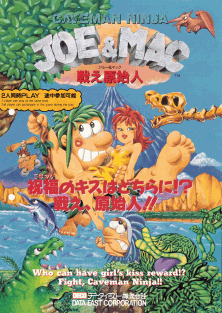Joe & Mac
This article has multiple issues. Please help improve it or discuss these issues on the talk page. (Learn how and when to remove these template messages)
No issues specified. Please specify issues, or remove this template. |
| Joe & Mac | |
|---|---|
 Japanese arcade flyer of Joe & Mac. | |
| Developer(s) | Data East (Arcade & SNES) Elite Systems (NES & Amiga) Eden Entertainment Software (Mega Drive/Genesis) New World Computing (PC) Motivetime (Game Boy) |
| Publisher(s) | Data East (Japan & North America Arcade & Nintendo console versions) Takara (North America Mega Drive/Genesis version) New World Computing (North America PC version) Elite Systems (Europe all versions) |
| Series | Joe & Mac |
| Platform(s) | Arcade, Super NES, Mega Drive/Genesis, Nintendo Entertainment System, Game Boy, Amiga, DOS, Zeebo |
| Release | 1991 |
| Genre(s) | Platform |
| Mode(s) | Single-player or Two-player |
Joe & Mac, Joe & Mac: Caveman Ninja in Europe, and Joe & Mac: Tatakae Genshijin (ジョーとマック 戦え原始人, Jō to Makku Tatakae Genshijin, "Joe and Mac: Fighting Cavemen") in Japan, is a 1991 platform game and brainchild of Jon Van Caneghem released for the arcades by Data East. It was later adapted for the Super NES, Mega Drive/Genesis, Nintendo Entertainment System, Game Boy, Amiga and PC.
Gameplay

The game stars the green-haired Joe and the blue-haired Mac, cavemen who battle though numerous prehistoric levels using, weapons such as boomerangs, bones, fire, flints, electricity, stone wheels, and clubs. The objective of the game is simply rescuing a group of girls who were kidnapped by a rival tribe of cavemen. The gameplay is somewhat similar to Contra and has a Gauntlet-style health system, where the player loses health over a period of time apart from in boss battles. This health system is also not unlike that of Sega's Wonder Boy.[citation needed] The game could be played in either single player or two player mode. In the two player mode, both characters could hurt each other. The game was also notable for its cartoony graphics, humor, and sound effects.[citation needed]
The original arcade version had the distinction of allowing the player to select between different routes (not unlike Taito's Darius) at the end of a boss battle. Also, after defeating the final boss, the players can choose between three exits, each one leading to a slightly different ending sequence.
Legacy
Ports
The DOS port is the most accurate home version to the arcade game, color wise, and technically speaking. The Mega Drive/Genesis version follows in arcade accuracy with only slightly reduced graphical and aural detail, resulting into the most accurate console version to the original arcade. The Super NES version is a reworked game which features an overworld map in order to choose the levels (unlike other versions all of them have to be played), which were longer, plus some bonus stages (either in the levels or out in the world map). Some of the weapons are missing and can no longer be charged up. The final boss is also different and there is only one ending. The NES and Game Boy versions are much downgraded versions of the original arcade version, and lack the possibility of choosing levels. A Zeebo version was announced with a release date sometime in 2010.[citation needed]
Sequels
The game later got two SNES sequels, Congo's Caper (though this is only referred in the Japanese version) and Joe & Mac 2: Lost in the Tropics, as well an arcade sequel titled Joe & Mac Returns.
Golgoth Studios is currently working on an HD remake for XBLA, PSN and PC.
